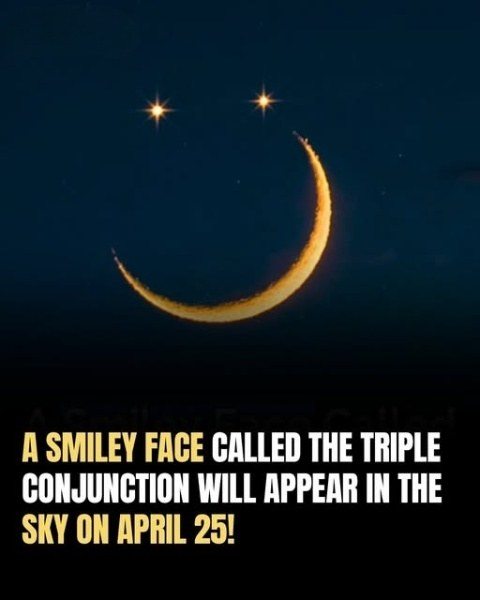Skywatchers across the globe should mark their calendars for April 25, 2025, when a rare celestial event will unfold, offering a breathtaking sight in the predawn skies. On this morning, a crescent moon, Venus, and Saturn will align in a unique way that astronomers call a “cosmic smile,” a phenomenon where the natural placement of these heavenly bodies resembles a cheerful face.

Unlike many astronomical events that demand specialized equipment or rare atmospheric conditions, this spectacle will be visible to anyone with an unobstructed view of the eastern horizon. Although planet and moon alignments occur from time to time, it is uncommon for them to form shapes that resemble familiar images like a smiling face, making this event particularly special. During this triple conjunction, Venus will shine as one “eye” higher up in the sky, while Saturn will form the second “eye” slightly lower, with the thin crescent moon positioned beneath them, completing the face with a curved “smile.”
Brenda Culbertson, a NASA Solar System Ambassador, explained to KSNT that the Moon’s slender crescent will serve as the grin in the triangular pattern formed with Venus and Saturn. Venus will outshine Saturn by about 25 times, appearing as a bright white point, while Saturn will glow with a golden hue, both seen as brilliant points to the naked eye. The best time to view this cosmic smile will be around 5:30 a.m. local time, roughly an hour before sunrise, regardless of where you are in the world. Since visibility diminishes as the sun approaches the horizon, early arrival is crucial, and allowing your eyes a few minutes to adjust to the darkness will enhance the experience.
Urban dwellers may face challenges from buildings blocking the view, so it’s better to head to rural areas or higher altitudes where the eastern horizon is clear. In some cases, Mercury might also make a surprise appearance much lower on the horizon, though spotting it should be seen as a bonus rather than part of the main alignment. For optimal viewing, choose a location free from obstructions like buildings or trees, such as east-facing beaches, elevated fields, or open plains.
Light pollution is another factor to consider, and heading away from city lights can dramatically improve the view. Online light pollution maps can help find the best nearby dark-sky locations. Weather conditions will play a big role too, as even a thin layer of clouds could obscure the smile. Check forecasts the night before and have a backup viewing spot if necessary. Observers in North America can benefit from specific recommendations: those on the Eastern Seaboard should head to ocean-facing beaches, Midwesterners should look for open rural fields, residents of the Mountain States should seek eastern-facing slopes, and those on the West Coast should find highlands overlooking eastern valleys. While no special equipment is needed to enjoy the cosmic smile, binoculars can enhance the experience by revealing finer details of the crescent moon and helping distinguish the planets more clearly. Models like 7×35 or 10×50 are great choices for beginners. Telescopes will provide even more detail, allowing viewers to glimpse Saturn’s rings and Venus’s phases, and with Mars reaching opposition later in April, telescope users will have plenty to explore. Smartphone apps such as Stellarium, Sky Guide, and NASA’s Sky Watch can help pinpoint the planets quickly and accurately, so it’s a good idea to familiarize yourself with these tools before the event. Families can make the experience even more memorable by introducing astronomy in a fun and accessible way, such as drawing the cosmic smile afterward, matching simple planet facts, or even trying basic photography. Be sure to dress warmly, bring chairs and blankets, and use red-filtered flashlights to protect night vision. A little preparation, like reviewing pictures of previous conjunctions and discussing what to expect, can build excitement, especially for younger skywatchers. Photography enthusiasts should secure their cameras or smartphones on tripods, use timers or voice commands to avoid shakes, and experiment with manual focus and exposure settings to capture the magic. Including foreground elements like trees or distant mountains can add a sense of scale and drama to the photos. In addition to this cosmic grin, April 2025 offers other skywatching treats like the Lyrid meteor shower around April 21–22 and Mars’s close approach around April 19, offering more reasons to gaze upward this month. Whether you’re observing with just your eyes, snapping photos, or introducing the wonders of the sky to your family, the planetary smile on April 25 promises a beautiful, fleeting connection to the cosmos that you won’t want to miss.





